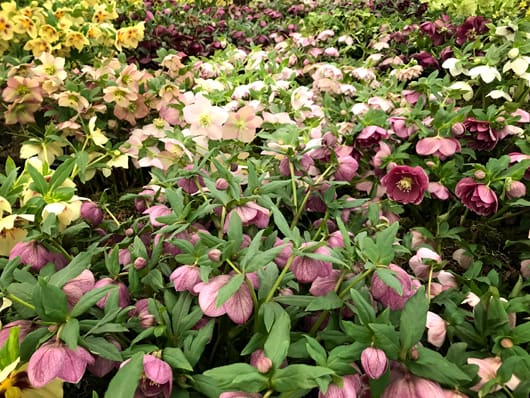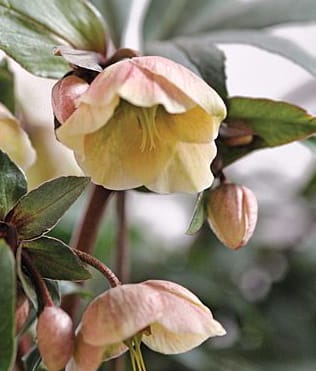Here at The Garden Barn, we think there is little to better the feeling of gazing into the garden and spotting the first signs of life re-emerging. Heavenly hellebores lead the way as they peek through frost-covered beds.
Hellebores come in a broad variety of shapes and colour, from the softly symmetrical to strikingly star-shaped. In hue, they vary from gently freckled whites to dramatic deep reds and moody purples, bringing a much-needed splash of colour to your garden in mid-winter.
When & Where:
Hellebores are not only beautiful, they’re also very versatile. Plant in early spring and position almost anywhere, as hellebores will tolerate most conditions with little complaint. In an ideal world they prefer well-drained, humus-rich soil in partial sunshine (recreating the conditions of an edge-of-woodland environment), but if that’s not something that you can provide don’t let it stop you from enjoying their magical winter grace.
Unlike many perennials, they prefer not to be divided or moved after they have been planted. All parts of the plant are toxic so handle with care. To ensure that you can enjoy them for years to come, take the time to think about positioning them where you will be able to enjoy their wintery beauty to the full extent. If planted in the right spot, hellebores will last for decades.

Tolerance & Resistance:
Hellebores can, if necessary, tolerate full sun but, where possible, appreciate being protected from the scorching midday glare in the peak of summer. They can also survive almost total shade, but prefer a bit of dappled sunlight to thrive.
Although they are not widely susceptible to disease or pests, hellebore black spot can occur if the foliage is left on all year, so we cut away the old leaves in the winter before the new flowers and foliage emerge in January (timing dependent on the variety).
As they freely self-seed ensure that they are either positioned somewhere where this is a bonus, not a hindrance or that you remove the flowering stems before they set seed in early May.
Wildlife:
Hellebores are a lifeline for bees. Their open-faced, enticing flowers, full of nectar and pollen, arrive at a time when our winged friends wake from their winter hibernation. They are also deer-resistant and so form a welcome inclusion to our country garden planting schemes.

Curious Cuttings:
Although commonly known as the Christmas Rose or Lenten Rose, the hellebore is in not related to the rose family at all.
With their pretty blossoms and emerald green to pewter foliage they also make a wonderful cut flower bouquet. Combine with other delicate blooms like ranunculus (which is of the same family), anemones, astrantias and an abundance of natural foliage. Or by simply cutting off the head of your hellebores and floating them in a suitably stylish vessel of water, they’ll bring serenity to a table setting at this time of year.
Discover more of our plant heroes, find town & country garden design inspiration and learn about landscaping with nature – Follow our stories here.


